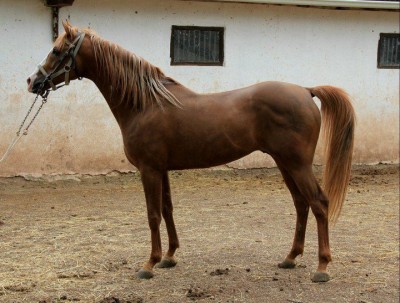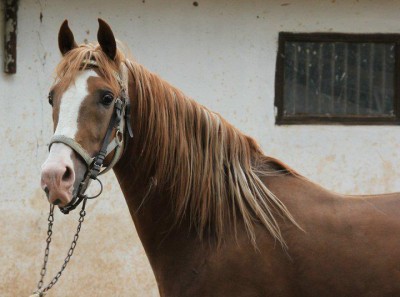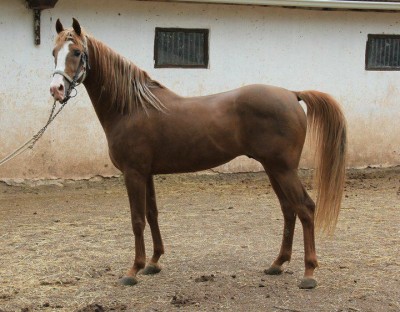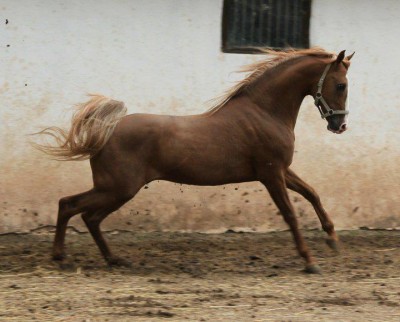Akman, 2003 Ma’naqi stallion from Turkey
Teymur from Germany sent me these photos of the very correct and well balanced stallion Akman, an Arabian horse of Turkish breeding. I know close to nothing about the pedigree, except that that the tail female mare, Matra, a bay 1927 Ma’naqiyah came to Turkey from the Bagdad area in 1931, and was bred by a certain Husayn al-Ali (of which there are a million people with the same name in Iraq). Here is a link to his pedigree. Thanks Teymur.




HOLY SMOKE! That is one beautiful arabian horse. his face make me think of the photos i have seen of the early american horse Abu Farwa. Stunning
Teymur: he appears to have everything. Neck, croup, bone,movement…Maybe his cannons are a bit long, but so what. Has he been frozen? Or has he been used for breeding. Is he Asil. What a horse…
Best wishes
Bruce Peek
Nice to see a real beautiful arabian horse!
László
He seems very tall. How tall is he?
What’s the bet he wouldn’t win in the showring because his back isn’t flat enough nor his head dishy enough. Yet he is no doubt superior to many i see in glossy photos winning the big ribbons.
I love this horse to bits, he is gorgeous. He might come to the Netherlands for breeding as I have been told 🙂 I hope so. I think he is Asil can anybody look that up??
someone needs to tell us whether some Turkish breeders ever played tricks with their Arabian racehorse breeding lines, like some French breeders did. If not, then all his ancestors seem to go back to desert lines.
Dish smish, you don’t ride heads. I can visualize him being crossed into some davenport lines. The Davenports having commendably short cannons. I bet youd get good size with the outcross, good disposition, and with both lines having clearly strong hindends further reinforce athletic ability. What about getting these guys registered for freezing? How complicated is it?
Best wishes
Bruce Peek
well make sure freezing is available in australia. we have woeful access to asils.
In Turkey they breed TB and Arabian horses for racing and not for Show…
It must always made blood tests, read more at the link from the Studbook in English.
There is no mix with TB-Blood, this is not a practice in Turkey.
Akman, is from a private breeder in Turkey, 157 cm ~ 15.2 hands, and should be sold to Russia, unfortunately, the sale failed because of various difficulties.
Surely he does not have Dish, but his eyes are very expressive for it. He is not a Show Horse…
Still, the majority of the Arabian horses in Turkey are “Asil”, but by the import of Polish Arabians from the United States and Poland in the 90ties, the Asil Arabian lines get lost.
The new creation is called the Silver Cross.
Unfortunately, the breeding of Arabian horses in Turkey, ignored by the rest of the world.
Why? no idea!.
Teymur, So are you saying there are a bunch more asil horses in Turkey that have been consciously kept asil? And that the breeding has been kept honest- meaning without sneaking in Thouroghbreds?
Wow what a resource that would be!
best wishes
Bruce Peek
Dear @Bruce Peek
Yes, absolutely
The historical background is different in Turkey than in France or Tunisia.
As always only the selection of racing performance has been applied.
Unfortunately, very little notice was taken of this Asil Arabian horses in other European countries.
And it would be a shame, if in the course of time through the use of non-asil horses this Asil-breeding would be lost.
In the U.S., (but were long ago), horses imported from Turkey.
Breeding has begun with the purchase of Arabian and Thoroughbred horses from Turkey or abroad by an expert committee.
The best examples of pure Arabian horses have been bought from the country such as Iraq and Syria and these horses breed according to the rules of zootechics science. As a result of selections and breeding techniques today’s generation that has supreme race performance has been achieved.
In 1928 Thoroughbred horses for breeding was imported the Karacabey stud from different countries. In addition private breeders had also imported horses for breeding from abroad.
In order to breed pure Arabian and Thoroughbred horses in accordance with science rules Arabian horse stud in Eski?ehir-Mahmudiye and ?anl?urfa and Thoroughbred horse stud in ?zmit and Bursa-Karacabey was built. In addition stallion cover station was opened in many places. Also in order to educate well informed stablemen P?narba?? Horse Education Center was constructed. In different periods our ministry apprentice, trainer and stablemen education courses.
In three managements of General Directorate of Agriculture Affair (TIGEM) private breeders’ pure Arabian racehorses began to take a great part in world Arabian horseracing society with their signboard. However recent years foals of Thoroughbred mares that are breed by private sector and covered by good quality stallions has begun to reach the world race performance.
Among horse races Arabian horse has a special quality with its nobility, harmony and good temperament. Since Arabian horse adjust the physical conditions easily and its foals take after their parents. Arabian horse has played direct or indirect role in the improvement of many horse races. Thoroughbred horse is one of the most important horses among these races.
Pure Arabian and Thoroughbred horse breed in Turkey are not only marked in the country but also they are exported Middle East countries.
Today there is a market of 3,5 – 4 million dollars for racehorses in the world. And our goal is to reach expected rate in international marketing.
Using the fund modern hippodrome and horses breeding establishment where our people enjoy themselves have been opened.
In order to make a good selection in racehorse breeding and for horse reformation it is very crucial to have a good organization for race.
Dear Teymur: I’m not exactly clear on this. As I recall there was some reference on other threads to Turkish arabs being crossed off of polish horses. This of course would render them no longer Asil, as we all know that the last few Asil polish horses were sold off in the early 60’s. Further we know that the Polish, and indeed entire eastern European breeding pattern with the creation of the Araber Rasse, Gidrans, Shagyas, and later french Anglo arabians and racing Arabians all involved at a minimum top crossing with thought to be asil stallions, to phonied up breedings in france. So that Skowronek for example was what 6 and 1/2percent Tarpan and Thoroughbred. Bask was said to be a few percent non arab. The spanish horses were likewise, just off the top of my head. Thats why I’m wondering what the percentages might be of Polish and other non asil blood in the Turkish horses.
Best wishes
Bruce Peek
Hello Bruce
Well today are a few are mixed, yes, with the Polish and US Arabian Horses.
But in the Ottoman Time, they was imp. Arabian-Horses from Bialocerkiew…
Only one Stallion: Erkürül Biza , a inbreed of the Idjanin D.B. Sireline, is found in the modern Turkish Arabian breeding program.
He’s daughter Sapha.1923 have Ancestor’s who traces back to the Bialocerkiew Arabian’s.
But i show the Pedigree of this Indjanin D.B., and i can’t say he’s Offspring wasn’t Asil…
Sure, if they new Polish Mixes from the imp. of the 90’s they are no longer Asil…
But …I must say Insallah…only a few Horses are mixed, the so called: Silver Cross…the other are the old Line’s from the foundation Horses of the 30s imp. from Irak, Syria and Lebanon…and 4 Mare’s from the Ottoman Stable’s….
three of them have also DB Ancestor’s…they have the Hujja…and only one the Mare Sapha.1923 goe’s back to the Bialocerkiew Polish Horse’s…about her Sire.
The photos of this chestnut stallion are wonderful. I can almost hear music from this horse, he’s so beautiful to my eye. I can’t remember ever seeing a photo that could almost sing with the harmony of a horse. Thank you for sharing the photos of Akman.